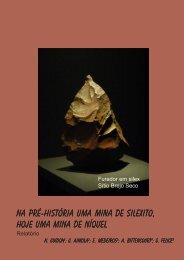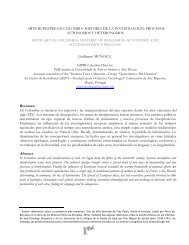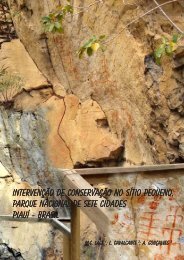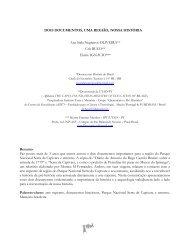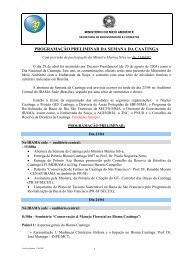Untitled - Fundação Museu do Homem Americano
Untitled - Fundação Museu do Homem Americano
Untitled - Fundação Museu do Homem Americano
You also want an ePaper? Increase the reach of your titles
YUMPU automatically turns print PDFs into web optimized ePapers that Google loves.
Weapons and Warriors: rare occurrences on British Megalithic Rock-Art<br />
George Nash - Reino Uni<strong>do</strong><br />
During the Early Bronze Age a number of core rock-art areas of Europe portray images that reflect a warrior<br />
society, shown either through weaponry or as warring scenes. This form of imagery is taken with vigour<br />
during the Middle, Late Bronze and Iron Ages (e.g. Valcamonica, northern Italy and Bohuslän, south-west<br />
Sweden), in the form of mainly statue menhirs and open exposed rock-art. In Britain, the <strong>do</strong>minant artistic<br />
movement that develops in the Neolithic and continues in the Early Bronze Age is abstract megalithic<br />
art. This distinct artistic form originates in Iberia and is usually associated with burial monuments. By<br />
the Late Neolithic many motifs that were carved onto burial monuments are transferred to exposed rock<br />
outcropping (mainly in northern Britain). On the island of Guernsey, within the Channel Islands are rare<br />
occurrences of human figures with supporting weaponry possibly reflecting in-part a warrior society. In<br />
association are several unique anthropomorphic figures that reflect the significance of the female form.<br />
Both sets of art have been looked at in detail, however this and other discussions have been based on<br />
what can be seen. Based on recent discoveries of each of the three Guernsey monuments, the author<br />
will attempt to shed a set of new interpretations on the role of establishing, phasing and using these<br />
most enigmatic monuments.<br />
(Artigo 62 IFRAO2009)<br />
Warrior Display in Brazilian Rock Art<br />
Reinal<strong>do</strong> Morales - Esta<strong>do</strong>s Uni<strong>do</strong>s da América<br />
68<br />
Warfare and weapon iconography is common in Brazilian rock art. In the Northeastern states of Bahia,<br />
Piauí and Rio Grande <strong>do</strong> Norte this imagery ranges from dynamic and brutal group scenes to stoic,<br />
elaborately decorated anthropomorphs. In some of the more sophisticated compositions the weaponry<br />
is prominently displayed yet there is no suggestion of action, a hunt, attack or otherwise. This sort of<br />
display iconography is found in other media elsewhere in prehistoric South America, and is reflected in<br />
the living arts of the Brazilian Indians. Considering the broader cultural landscape, the rock art may have<br />
worked as gendered display.<br />
Le Figure di Ascia della Prima Età del Ferro nell’arte Rupestre della Valcamonica<br />
Linda Bossoni - Itália<br />
Le raffigurazioni di armi costituiscono da sempre un soggetto importante nell’ambito degli studi riguardanti<br />
l’arte rupestre, soprattutto per la possibilità che offrono di effettuare confronti con la cultura materiale e<br />
quindi fornire indicazioni cronologiche alle incisioni ad esse correlate. In Valcamonica, le figure di asce<br />
compaiono, nel corso dell’età del Rame sui massi incisi e trovano poi una spazio particolare nell’arte<br />
rupestre dell’età del Bronzo, in primo luogo nelle aree di Foppe di Nadro e Luine. Per quanto riguarda l’età<br />
del Ferro sono ormai ben conosciute e studiate le figure di ascia a lama espansa a taglio diritto e a lama<br />
espansa a taglio semilunato, le prime cronologicamente riferibili al III sec. a.C., le seconde ad un perio<strong>do</strong><br />
compreso tra la metà del II sec. a.C. e la prima metà del I sec. d.C. Queste figure, caratterizzate da una<br />
notevole varietà iconografica, sono state individuate sino ad ora nelle aree di Paspar<strong>do</strong>, Campanine,<br />
Foppe di Nadro, Naquane, Pagherina, mentre non sono state ancora rinvenute sul versante destro delle<br />
valle. Si è, cercato di comprendere il significato di queste figure, indagan<strong>do</strong> sia l’ascia come simbolo, sia<br />
i contesti in cui queste raffigurazioni appaiono nell’arte rupestre camuna, in particolare associazione a<br />
figure che rimandano ad un contesto iniziatico, come il labirinto, i pediformi e gli ornitomorfi.<br />
Fighting in ancient Arnhem Land: archaic Australian pictures of mass warfare<br />
Christopher Chippindale - Reino Uni<strong>do</strong><br />
Although pictures of weapons which could be used in fighting are common in many bodies of rock-art,<br />
clear images of fighting are rarer. Unambiguous pictures of fights are a distinctive though uncommon<br />
element in one phase of the long and well-dated rock-art sequence of Arnhem Land, north Australia. They<br />
show two massed groups in opposition, well armed, with spears in flight between them, with some of the<br />
warriors pierced by the spears. And these striking images are at a date when we can be fairly sure there<br />
was cause for much movement of populations, and therefore cause for dispute over land and warfare.<br />
FUMDHAMentos IX




